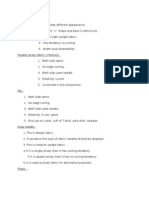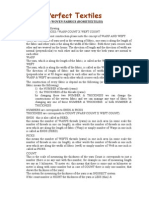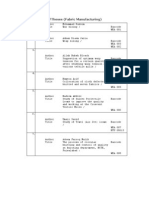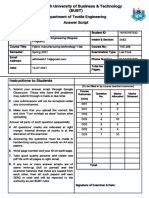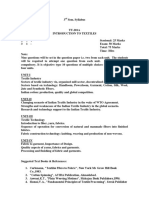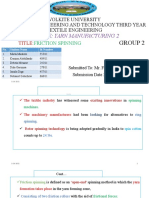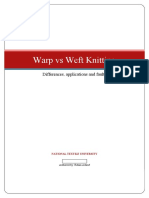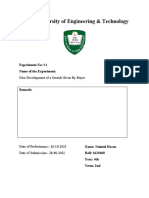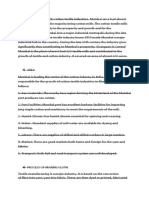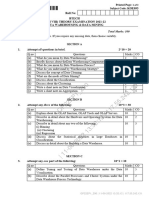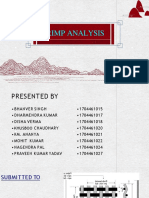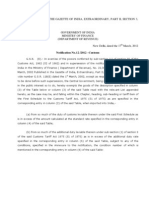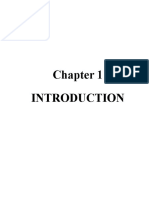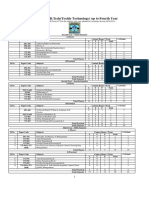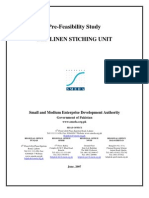COIMBATORE
COIMBATORE
Uploaded by
YashCopyright:
Available Formats
COIMBATORE
COIMBATORE
Uploaded by
YashOriginal Title
Copyright
Available Formats
Share this document
Did you find this document useful?
Is this content inappropriate?
Copyright:
Available Formats
COIMBATORE
COIMBATORE
Uploaded by
YashCopyright:
Available Formats
Mumbai is famous for its cotton textile industries.
Mumbai once had almost
130 textile mills, with the majority being cotton mills. The cotton textile mills
contributed significantly to the prosperity and growth and for the
transformation of Mumbai into a major industrial metropolis during the late
nineteenth century. The textile industry boom 1854 made Mumbai a major
industrial hub in the country. During the late 19th century the industry grew
significantly thus contributing to Mumbai’s prosperity. Girangaon in Central
Mumbai is the place where it had 130 textile mills and contributed to the
growth of textile and cotton industry. It covered an area of almost 600 acres.
AREA
Mumbai is leading the centre of the cotton industry in India. Factors
responsible for the growth of cotton textile industries in Mumbai are as
follows:
1. Raw materials: The nearby lava region forming the hinterland of the Mumbai
port produces raw cotton.
2. Port Facilities: Mumbai port has excellent harbour facilities for importing
long staple cotton and machinery to meet the requirements of the mill.
3. Humid Climate: has humid climate essential for spinning and weaving.
4. Water: Abundant supplies of soft water are available for dyeing and
bleaching.
5. Labour: There are supplies of skilled and skilled workers in large number.
8. Market: There are good markets both home and foreign for the yarn and
fabrics.
9. Transport: Both Rail and road transport system are well developed.
PROCESS OF MAKING CLOTH
Textile manufacturing is a major industry. It is based on the conversion
of fibre into yarn, yarn into fabric. These are then dyed or printed, fabricated
into clothes. Different types of fibres are used to produce yarn. Cotton remains
the most important natural fibre, so is treated in depth. There are many
variable processes available at the spinning and fabric-forming stages coupled
with the complexities of the finishing and colouration processes to the
production of a wide range of products. There are six stages:
Cultivating and Harvesting
Preparatory Processes
Spinning
Weaving or Knitting
Finishing
Marketing
SPINNING-YARN MANUFACTURE---Most spinning today is done using Break or
Open-end spinning; this is a technique where the staples are blown by air into
a rotating drum, where they attach themselves to the tail of formed yarn that
is continually being drawn out of the chamber. Other methods of break
spinning use needles and electrostatic forces. This method has replaced the
older methods of ring and mule spinning. It is also easily adapted for fibres.
The spinning machines take the roving thins it and twists it, creating yarn
which it winds onto a bobbin.
WEAVING-FABRIC MANUFACTURE---The weaving process uses a loom. The
lengthways threads are known as the warp, and the cross way threads are
known as the weft. The warp, which must be strong, needs to be presented to
loom on a warp beam. The weft passes across the loom in a shuttle that carries
the yarn on a prim. These pirns are automatically changed by the loom. Thus,
the yarn needs to be wrapped onto a beam and onto pirns before weaving can
commence.
FINISHING-PROCESSING OF TEXTILES--- The woven cotton fabric in its loom-
state not only contains impurities, including warp size, but requires further
treatment in order to develop its full textile potential. Furthermore, it may
receive considerable added value by applying one or more finishing processes.
MAIN PRODUCION UNITS
1. Raymond Ltd is largest integrated manufacturer of fabric in the world
based in Mumbai, Maharashtra. It has over 60% market share in suiting
in India.
2. Bombay Dyeing & Mfg Company Limited (Bombay Dyeing) is one of
India's largest producers of textiles.
1. Mandhana Industries Limited is an Indian diversified textile and apparel
manufacturing company, headquartered in Mumbai, Maharashtra.
TEXTILE MILL IN MUMBAI
A boom in the textile industry followed, with 10 cotton mills set up in Mumbai
by 1865, employing over 6,500 workers. A gradual increase led to a total of 136
mills being set up by 1900. The textile industry was offered added government
incentives in the form of long term leases (some as mills stimulated the
economic growth and employment).
MARKET
Mumbai is the collecting centre of raw cotton for export and mills use. For that
purpose, Mumbai possesses a well-knit transport system by rail and road.
Mumbai port has excellent harbour facilities for importing long staple cotton
and machinery to meet the requirements of the mill. There are good markets
both home and foreign for the yarn and fabrics. Both Rail and road transport
system are well developed.
You might also like
- Modern Cotton Spinning Machinery, Its Principles and ConstructionFrom EverandModern Cotton Spinning Machinery, Its Principles and ConstructionNo ratings yet
- Single Jersey FabricDocument4 pagesSingle Jersey FabricMrcr Kapzap0% (1)
- Garment Worker Safety: Chemicals Also Play A Part in Garment Manufacturing. Dyes, Enzymes, Solvents, and OtherDocument4 pagesGarment Worker Safety: Chemicals Also Play A Part in Garment Manufacturing. Dyes, Enzymes, Solvents, and Othernarendra100% (1)
- FA - Geosynthetics LaboratoryDocument43 pagesFA - Geosynthetics LaboratoryJufriadi Civil EngineeringNo ratings yet
- Him SonDocument41 pagesHim Sonviren199008No ratings yet
- Yarn Preparation For Weaving and KnittingDocument5 pagesYarn Preparation For Weaving and KnittingamoralaeddineNo ratings yet
- Syllabus 3-8th SemesterDocument56 pagesSyllabus 3-8th Semesterapi-287058159No ratings yet
- The Need For Proper Classification of FabricsDocument10 pagesThe Need For Proper Classification of FabricsJie LiNo ratings yet
- Textiles Product InformationDocument6 pagesTextiles Product InformationTeodoro CornejoNo ratings yet
- Weaving Technology LEC1Document10 pagesWeaving Technology LEC1Suza Ahmed AuporboNo ratings yet
- Seminar 3Document40 pagesSeminar 3Solomon Solostar JacobNo ratings yet
- Elements of Circular KnittingDocument5 pagesElements of Circular KnittingSanika JoshiNo ratings yet
- Airjet PracDocument12 pagesAirjet PracJunaid SuhailNo ratings yet
- Training Report of Gcti Tarinees MS WORDDocument55 pagesTraining Report of Gcti Tarinees MS WORDAakash NagpalNo ratings yet
- List of Project Theses (Fabric Manufacturing)Document14 pagesList of Project Theses (Fabric Manufacturing)Rasheduzzaman RashedNo ratings yet
- KahatexDocument14 pagesKahatexDaalac Daahir Shoot100% (1)
- The Knitting Compendium 3Document22 pagesThe Knitting Compendium 3kathirvelus9408No ratings yet
- 2 GinningDocument29 pages2 GinningPrincesaxena SaxenaNo ratings yet
- Các loại lỗi trên vảiDocument17 pagesCác loại lỗi trên vảiTrang100% (1)
- Fabric Manufacturing Technology Lab-1 Final Exam SolutionDocument16 pagesFabric Manufacturing Technology Lab-1 Final Exam SolutionAlif SheikhNo ratings yet
- Yarn HairinessDocument9 pagesYarn HairinessGhandi AhmadNo ratings yet
- Advances in Weaving Technol...Document9 pagesAdvances in Weaving Technol...Fabric Club100% (1)
- Textile Fibre Yarn CountDocument30 pagesTextile Fibre Yarn CountSujit GulhaneNo ratings yet
- Concept of High Volume Instrument (HVI) HVI Used in Bale MDocument15 pagesConcept of High Volume Instrument (HVI) HVI Used in Bale MS.m. MahasinNo ratings yet
- Internship Training: Submitted by - Gaurav Sisodiya Sanmitra Pomane Akash Nimbalkar Girish MohiteDocument30 pagesInternship Training: Submitted by - Gaurav Sisodiya Sanmitra Pomane Akash Nimbalkar Girish MohiteAditya RainaNo ratings yet
- Melt Spinning Process - Feature of Melt Spinning - Advantages and Disadvantage of Melt Spinning - Textile LearnerDocument4 pagesMelt Spinning Process - Feature of Melt Spinning - Advantages and Disadvantage of Melt Spinning - Textile LearnerrajinderNo ratings yet
- Btech Syllabus Textile EngineeringDocument68 pagesBtech Syllabus Textile EngineeringShubham BansalNo ratings yet
- Fabric Science - I: Unit-4 Testing of FibresDocument24 pagesFabric Science - I: Unit-4 Testing of FibresRAHUL16398No ratings yet
- Fibres Yarns and FabricDocument4 pagesFibres Yarns and Fabricapi-281768577No ratings yet
- Yarn Waxing XXXXXXXDocument23 pagesYarn Waxing XXXXXXXTamer Farouk Khalifa100% (1)
- Fabric IV PPT MahasinDocument12 pagesFabric IV PPT MahasinS.m. MahasinNo ratings yet
- Spin Plan Bengal ThesisDocument149 pagesSpin Plan Bengal Thesisstylish eagleNo ratings yet
- Course: Yarn Manufacturing 2Document24 pagesCourse: Yarn Manufacturing 2fekadeNo ratings yet
- Comparative Study On Ring, Rotor and Air-Jet Spun Yarn: Sharif AhmedDocument14 pagesComparative Study On Ring, Rotor and Air-Jet Spun Yarn: Sharif Ahmedgizex2013No ratings yet
- YEM 2 (LAB) Group-2Document32 pagesYEM 2 (LAB) Group-2mortuza hasanNo ratings yet
- Application of Warp Knitting CAD SystemDocument26 pagesApplication of Warp Knitting CAD SystemJamal Haider HasibNo ratings yet
- Practical Observation of Material Flow On Ring-Fame, Auto Cone Rotor SpinningDocument5 pagesPractical Observation of Material Flow On Ring-Fame, Auto Cone Rotor SpinningTalha saeedNo ratings yet
- Compact SpinningDocument7 pagesCompact Spinningag015708No ratings yet
- Fabric TestingDocument24 pagesFabric Testingjob wabwire100% (1)
- Knitting Productivity Improvement TipsDocument6 pagesKnitting Productivity Improvement TipsDr Muhammad Mushtaq MangatNo ratings yet
- Staple or FilamentDocument30 pagesStaple or Filamentapi-232403733No ratings yet
- Cost Analysis: Quality Comes First, Rest Are ConsequencesDocument5 pagesCost Analysis: Quality Comes First, Rest Are ConsequencesAl AminNo ratings yet
- Textile Testing Presentation On Uster Tansorapid by Pritpal SinghDocument13 pagesTextile Testing Presentation On Uster Tansorapid by Pritpal SinghPritpalSingh0% (1)
- Melange: The New Innovation in Textile With Melange: Case StudyDocument8 pagesMelange: The New Innovation in Textile With Melange: Case StudyFalgon IslamNo ratings yet
- Weaving Process Interlaces The WarpDocument8 pagesWeaving Process Interlaces The WarpChetna SinghNo ratings yet
- Wrapper Fibres in Open-End Rotor-Spun Yarns Yarn Properties and Wrapper FibresDocument8 pagesWrapper Fibres in Open-End Rotor-Spun Yarns Yarn Properties and Wrapper FibresAhmad BabiNo ratings yet
- Chapter 5 Fabric PropertiesDocument21 pagesChapter 5 Fabric PropertiesNURUL ZAKIAH ZAMRI TANNo ratings yet
- Patterning in Weft Knitting: Waqas AshrafDocument33 pagesPatterning in Weft Knitting: Waqas AshrafHifza khalidNo ratings yet
- Fabric Science-Ii: Subject Code: 17UTF09Document111 pagesFabric Science-Ii: Subject Code: 17UTF09Sweatha S100% (1)
- Textile Lab Report TitleDocument3 pagesTextile Lab Report TitlezubairNo ratings yet
- Textile SpinningDocument30 pagesTextile SpinningTeka Weldekidan AbebeNo ratings yet
- Warp Vs Weft KnittingDocument5 pagesWarp Vs Weft KnittingLinh NguyenNo ratings yet
- New Development of A Swatch Given by BuyerDocument11 pagesNew Development of A Swatch Given by BuyerNaimul Hasan0% (1)
- Unit - IiDocument27 pagesUnit - IiJoseph KuruvilaNo ratings yet
- Weft KnittingDocument62 pagesWeft KnittingAbhinav VermaNo ratings yet
- Unit 2Document76 pagesUnit 2Vaibhav SinglaNo ratings yet
- Fabric DefectsDocument30 pagesFabric DefectsFahima RashidNo ratings yet
- List of BooksDocument4 pagesList of BooksPrathmesh BharukaNo ratings yet
- Spinning Maths-1Document12 pagesSpinning Maths-1tsukuyomi03No ratings yet
- COIMBATOREDocument3 pagesCOIMBATOREYashNo ratings yet
- Data Warehousing Data Mining Koe093Document2 pagesData Warehousing Data Mining Koe093YashNo ratings yet
- Introduction To Smart Grid Koe084Document2 pagesIntroduction To Smart Grid Koe084YashNo ratings yet
- Applied ThermodynamicsDocument160 pagesApplied ThermodynamicsYashNo ratings yet
- Bio Medical Signal Processing Koe082Document2 pagesBio Medical Signal Processing Koe082YashNo ratings yet
- Emerging Technology For Engineering KMC202Document1 pageEmerging Technology For Engineering KMC202YashNo ratings yet
- AHMEDABADDocument3 pagesAHMEDABADYashNo ratings yet
- COIMBATOREDocument3 pagesCOIMBATOREYashNo ratings yet
- COIMBATOREDocument3 pagesCOIMBATOREYashNo ratings yet
- AHMEDABADDocument3 pagesAHMEDABADYashNo ratings yet
- Quench APYDocument8 pagesQuench APYKetan GandhiNo ratings yet
- Means Business: Madhya PradeshDocument56 pagesMeans Business: Madhya Pradeshravikiran1955No ratings yet
- Unlock-Treinamento Netstal Discjet 600Document308 pagesUnlock-Treinamento Netstal Discjet 600marioNo ratings yet
- Textile IndustryDocument94 pagesTextile IndustryPayalAgarwal100% (2)
- History of CostumesDocument4 pagesHistory of CostumesnitakuriNo ratings yet
- Recycling of Post-Industrial Cotton Wastes: Quality and Rotor Spinning of Reclaimed FibersDocument10 pagesRecycling of Post-Industrial Cotton Wastes: Quality and Rotor Spinning of Reclaimed Fibersparus bukhariNo ratings yet
- Crimp AnalysisDocument24 pagesCrimp AnalysisShivam babyNo ratings yet
- Architectural Membranes: Case StudiesDocument48 pagesArchitectural Membranes: Case Studiescvengr229No ratings yet
- Operation ManualDocument56 pagesOperation ManualAtef GhorbelNo ratings yet
- Eurolaser Product Overview GBRDocument42 pagesEurolaser Product Overview GBRpaul300No ratings yet
- Textile Arts of Minorities HazelDocument26 pagesTextile Arts of Minorities HazelCarla LacubtanNo ratings yet
- Cus 1212Document151 pagesCus 1212Sivakumar AmbikapathyNo ratings yet
- Souvenir TEXCON 2021Document48 pagesSouvenir TEXCON 2021Rajendra GautamNo ratings yet
- PublicPaper Dorn PDFDocument32 pagesPublicPaper Dorn PDFAnonymous 07vOE7U31LNo ratings yet
- GopiDocument63 pagesGopipriyaNo ratings yet
- Arima Central Secondary SchoolDocument3 pagesArima Central Secondary SchoolAisha FosterNo ratings yet
- Introducing The Fashion of The Future - Chavez Cabrera Francisco AdrielDocument3 pagesIntroducing The Fashion of The Future - Chavez Cabrera Francisco AdrielAdriel GamesNo ratings yet
- Btle He10 Clothing Construction RevisedDocument12 pagesBtle He10 Clothing Construction RevisedJun BelloNo ratings yet
- Managing A Global Workforce Challenges and Opportunities in International Human Resource ManagementDocument460 pagesManaging A Global Workforce Challenges and Opportunities in International Human Resource ManagementSkylar SuNo ratings yet
- Syllabus PDFDocument51 pagesSyllabus PDFPalashNo ratings yet
- Report by Mary Grace I. ValilaDocument37 pagesReport by Mary Grace I. ValilaJocelyn GaniaNo ratings yet
- Ladies Gowns & NightyDocument8 pagesLadies Gowns & Nighty124swadeshiNo ratings yet
- Gcse Fashion CourseworkDocument4 pagesGcse Fashion Courseworkf5dmncxc100% (2)
- Performance Improvement of Textile Sector by Implementing Quality Six Sigma (QSS)Document6 pagesPerformance Improvement of Textile Sector by Implementing Quality Six Sigma (QSS)International Journal of Application or Innovation in Engineering & ManagementNo ratings yet
- Concrete ClothDocument20 pagesConcrete ClothShrinivasNo ratings yet
- SMEDA Bed Linen Stitching UnitDocument20 pagesSMEDA Bed Linen Stitching UnitMuhammad Ali RazaNo ratings yet
- Journal of Cleaner Production: A. Vinod, M.R. Sanjay, Siengchin Suchart, Parameswaranpillai JyotishkumarDocument27 pagesJournal of Cleaner Production: A. Vinod, M.R. Sanjay, Siengchin Suchart, Parameswaranpillai JyotishkumarSiddharthBhasneyNo ratings yet
- AZO Chemicals ListDocument2 pagesAZO Chemicals Listritvikjindal100% (1)

